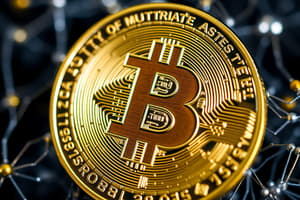Podcast
Questions and Answers
What is the primary function of a utility token in blockchain technology?
What is the primary function of a utility token in blockchain technology?
- Represents unique digital items such as art.
- Offers access to specific products or services. (correct)
- Facilitates the validation of transactions.
- Provides ownership of an asset like real estate.
Which process involves the validation of transactions and their addition to a blockchain?
Which process involves the validation of transactions and their addition to a blockchain?
- Validating
- Sharding
- Mining (correct)
- Forking
In decentralized finance (DeFi), what is the main benefit of using blockchain technology?
In decentralized finance (DeFi), what is the main benefit of using blockchain technology?
- The enhancement of transaction speed through centralized methods.
- Elimination of intermediaries for financial services. (correct)
- The requirement for intermediaries in transactions.
- The use of traditional banking systems for transactions.
What role does a governance token play in a blockchain or DeFi project?
What role does a governance token play in a blockchain or DeFi project?
Which technique is utilized to improve the scalability of blockchains by partitioning it into smaller parts?
Which technique is utilized to improve the scalability of blockchains by partitioning it into smaller parts?
What is the main function of a block in a blockchain?
What is the main function of a block in a blockchain?
Which consensus mechanism requires participants to solve complex puzzles for transaction validation?
Which consensus mechanism requires participants to solve complex puzzles for transaction validation?
What defines a public blockchain?
What defines a public blockchain?
What role does a private key play in blockchain security?
What role does a private key play in blockchain security?
Which statement about the genesis block is true?
Which statement about the genesis block is true?
What describes a consortium blockchain?
What describes a consortium blockchain?
How does a digital signature contribute to blockchain security?
How does a digital signature contribute to blockchain security?
What is a key characteristic of Distributed Ledger Technology (DLT)?
What is a key characteristic of Distributed Ledger Technology (DLT)?
Flashcards are hidden until you start studying
Study Notes
Blockchain Fundamentals
- A blockchain is a decentralized digital ledger that records transactions in blocks, chained together chronologically.
- Blocks contain data, timestamp, and a cryptographic hash (unique identifier) of the previous block.
- The first block in a chain is called the Genesis Block, serving as the foundation.
- Nodes are devices on the network, each maintaining a copy of the blockchain, ensuring data integrity.
- Distributed Ledger Technology (DLT) refers to digital systems recording data spread across multiple nodes for increased security and transparency.
Consensus Mechanisms
- Consensus enables network agreement on transaction validity.
- Proof of Work (PoW) requires miners to solve complex puzzles to validate transactions (e.g., Bitcoin).
- Proof of Stake (PoS) selects validators based on the amount of cryptocurrency they hold, earning them rewards for validating transactions.
- Delegated Proof of Stake (DPoS) allows stakeholders to elect delegates (validators) to participate in consensus.
- Practical Byzantine Fault Tolerance (PBFT) is a consensus mechanism designed to handle potentially malicious nodes (Byzantine faults).
Cryptography & Security
- Hash functions convert data into unique fixed-length strings (hashes) for data integrity.
- Cryptographic hashes (like SHA-256) ensure data integrity by being unique for specific input data.
- Public Keys are used to receive funds and are shared publicly.
- Private Keys are secret keys used to sign transactions and prove ownership.
- Digital Signatures use cryptography to ensure message or transaction authenticity.
Blockchain Network Types
- Public Blockchains are open networks like Bitcoin and Ethereum, accessible to anyone.
- Private Blockchains are restricted networks controlled by a specific organization.
- Consortium Blockchains are semi-decentralized networks managed by a group of organizations.
- Permissioned Blockchains require permission to join the network, allowing selective access.
Smart Contracts & Tokens
- Smart Contracts are self-executing code stored on a blockchain that automatically executes when predefined conditions are met.
- Tokens are digital assets created on existing blockchains, such as ERC-20 tokens on Ethereum.
- Utility Tokens provide access to products or services (e.g., Filecoin).
- Security Tokens represent ownership of an asset, such as shares or real estate.
- Non-Fungible Tokens (NFTs) are unique digital assets representing specific items, like artwork and collectibles.
Transactions & Fees
- Transactions are records of asset movements on a blockchain (like transferring cryptocurrency).
- Gas Fees are paid to miners or validators to process transactions on a network (used in Ethereum).
- Mining is the process of validating transactions and adding them to the blockchain (primarily in PoW networks).
- Validators are responsible for verifying new transactions in PoS networks.
Blockchain Scalability & Layered Solutions
- Layer 1 refers to the base blockchain (e.g., Bitcoin, Ethereum).
- Layer 2 solutions are off-chain solutions that enhance blockchain scalability (e.g., Lightning Network, Polygon).
- Forking is a split in a blockchain into two separate paths, often triggered by protocol changes, a hard fork or a soft fork.
- Sharding divides the blockchain into smaller partitions (shards) to improve scalability.
Decentralized Finance (DeFi) & Governance
- DeFi refers to financial services (lending, borrowing, trading) built on public blockchains without intermediaries.
- Decentralized Autonomous Organizations (DAOs) are community-driven organizations where decisions are made collectively using smart contracts.
- Governance Tokens allow holders to vote on changes in a blockchain or DeFi project.
Studying That Suits You
Use AI to generate personalized quizzes and flashcards to suit your learning preferences.




